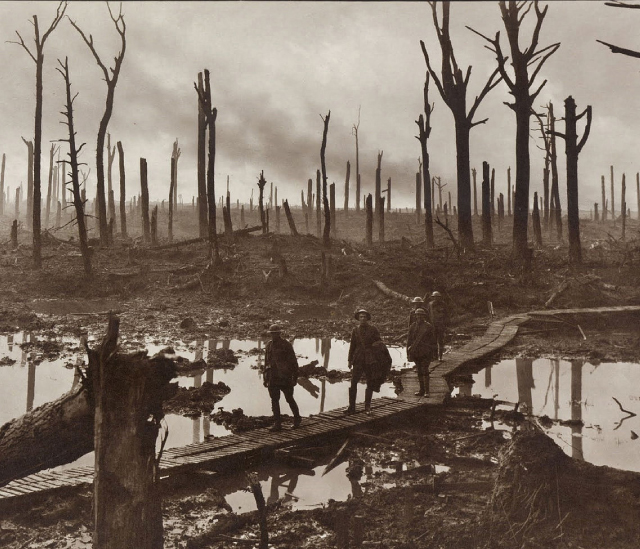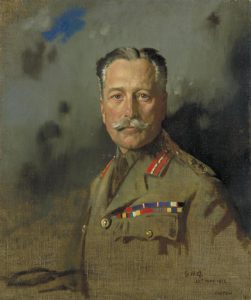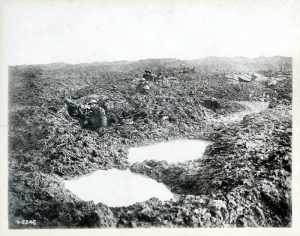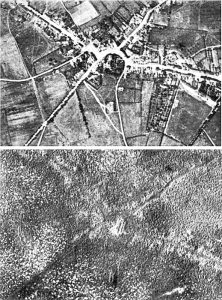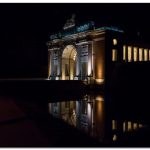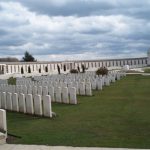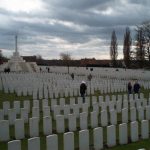On 31st July 1917, the British army launched an attack against German positions near Ypres. This attack, though officially the Third Battle of Ypres, became known as the Battle of Passchendaele, after one of the villages in which the battle was fought. It has come to define many of the modern views of the First World War.
1917 was a trying year for the Entente Allies. Following on from the battles and huge casualties sustained at the Somme and Verdun in 1916, Britain, France, Italy, and Russia continued searching for ways to break the German army and bring the war to a conclusion as it entered yet another year.
However, revolutions in Russia brought that nation to its knees and would eventually see them quit the conflict all together. A failed French attack at the Chemin des Dames during April and May, caused an outbreak of mutiny within their army and left the French unable to carry out any attacks for the rest of the year. Whilst the Italians had forced the Austrian-Hungarian armies back on their own front, German forces soon arrived to assist their beleaguered allies and quickly prevented any further advances.
Whilst the United States of America had recently joined the war, their first contingent of soldiers only began to arrive at the end of June 1917, and their army would not be ready for combat operations until the following year.
For the second half of 1917, Britain was the only allied power able to launch attacks against Germany. Given a free hand to pick his target, Field Marshal Haig once again turned his attention to the area around Flanders in Belgium, where a successful assault could capture German U-Boat pens and potentially turn the flank of the enemy army.
Battles of Ypres
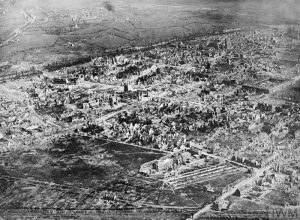
Aerial oblique view of Ypres showing the ruins of the city. – Image Courtesy of the Imperial War Museum (IWM Q 29795)
Fighting had first begun around Ypres towards the end of 1914. Following the ‘Race to the Sea’ and creation of trenches along the Western Front, the ancient walled city of Ypres took up a crucial position in the front lines. Whilst the city was on the allied side its defenses caused a bulge in the front line which jutted out into German held territory.
This salient meant that British and French forces could attack out of Ypres and, if they could break through the German lines, would be able to move into the open countryside behind the German defenses and potentially surround the German army. However, this same situation allowed the Germans to bombard the city from three sides in an attempt to destroy the defending forces.
The First Battle of Ypres in October and November 1914, saw British, French, and Belgian armies fight against the Germans in order to keep control of the city. Whilst neither side was able to force the other from their positions, the allies continued to hold the city and keep their front line positions a safer distance in front of the city itself.
On 22nd April 1915, the German army used poison gas for the first time near Ypres in a new attempt to drive the defenders from the area and seize the position. This Second Battle of Ypres lasted for a month and the German army was able to push the front lines back towards the city but were unable to capture it.
Whilst other battles in 1916, such as the Somme, moved the focus of attention away from the Ypres area, Douglas Haig remained keen on a breakthrough in the area. Success along the Belgian coast would help protect Britain from the threat of German U-Boats and would provide a recognisable moment of victory for those back home. Perhaps just as importantly, however, it would also help guarantee a clear route of escape out of Europe should the war turn badly.
Following the failure of the French offensives in April and May 1917, the difficulties facing Russia and Italy, and the slow movement of the United States, responsibility for offensive operations fell to the British. Haig had the opportunity he desired to force the issue in Flanders. His choice of target was not universally welcomed however. Over the objections of the French army and concerns of the British government, Haig pressed his case and won permission to stage his attack.
Haig’s Plan
Whilst the front lines had tightened around Ypres during the battles of 1914 and 1915, the basic situation remained the same. The city continued to be surrounded on three sides by the German army.
The landscape around Ypres greatly benefited the Germans. Hills and ridges to the east allowed the German army to bombard allied positions and observe the movement of the defending forces. Haig intended to force the Germans off some of these hills and secure them for allied operations.
The village of Passchendaele lay on one of these hills slightly to the north east of Ypres. A further 5 miles beyond it lay a key railway hub that the German army was using for resupply.
Haig’s initial aim was to capture the strategic hills and ridges around Ypres and then begin the process of pushing through the German defenses, capturing railway and supply junctions along the way. A further series of assaults, including a planned amphibious attack, along the coast would help to compromise the German line in Belgium.
However, the landscape that made Ypres so important also severely restricted the possibilities for prolonged fighting. The ground in Flanders is composed of a mix of sand, silt, and clay. The area was criss-crossed with drainage ditches and was prone to flooding given the high water table. Many of the ditches which were required to drain water away from the battlefield had already been destroyed by fighting.
Although research suggested that the weather in Ypres had been steadily improving year on year, starting in August 1917, Flanders experienced one of the worst years for rain on record.
Third Battle of Ypres
The initial British objectives were the Gheluvelt Plateau and Pilckem Ridge. If these two positions could be captured early on they would provide a powerful platform for British artillery to then cover the advance.
The British began their attacks on these objectives at 3:50am on 31st July 1917. The time had initially been chosen because it corresponded with dawn, but low-hanging cloud obscured the sun and ensured that the British soldiers advanced in darkness.
The early part of the day saw initial British successes but, as the day wore on the attacks began to stall as German defenders rushed to the area and began to counter-attack against positions the British had only recently captured and had not yet been able to fortify.
The British were able to make some notable gains at Pilckem Ridge but the fighting was harder around Gheluvelt. The situation became tougher still when it began to rain.
The British continued to launch further offensive operations throughout August and began the process of forcing the German army slowly backwards.
To assist in the advance, supporting attacks were made in the surrounding area to draw German soldiers away from the main thrust and also capture other strategically useful positions. One of these attacks saw Canadian forces capture the German position at Hill 70. This position would allow British forces to give further artillery support to their own attacks and, in capturing it, the Canadians sustained around 9,000 casualties but inflicted over 25,000 on the Germans.
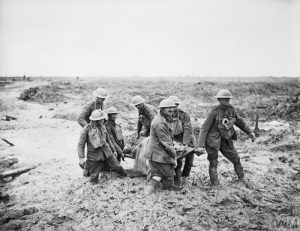
Battle of Pilckem Ridge. Stretcher bearers struggle in mud up to their knees to carry a wounded man to safety near Boesinghe, 1 August 1917 – Image Courtesy of the Imperial War Museum (IWM Q 5935)
The deteriorating weather conditions continued to make combat difficult. Over the course of August, 5 inches of rain fell in the area. Artillery bombardments tore up the ground and further destroyed drainage ditches. Attempts to dig new trenches did little more than open a succession of muddy puddles.
Haig had, justifiably, not anticipated the weather being so poor throughout August. However, though the weather continued to worsen, he continued with his plan of attack.
Throughout August and into September, the British army continued to attack German positions and force the line away from Ypres and back towards the village of Passchendaele.
Muddy Advance
With the objective of Passchendaele nominally in sight towards the end of September, Haig maintained the offensive into October.
However, the bad weather which had begun in August had not noticeably lifted in the months that followed. The change from late summer into autumn and, eventually, winter would bring no respite for the soldiers in the area.
Traditional front lines had ceased to exist in some areas. Digging new trenches in water-logged ground was useless. So men tried to construct defenses in shell craters or the remnants of previous fortifications. Whilst the mud made any defenses more sophisticated than this impossible, it also became a real danger to the lives of soldiers.
Looking back after the war, Gunner Jack Dillon described the potential dangers of the terrain:
Now the mud at Passchendaele was very viscous indeed, very tenacious, it stuck to you. The mud there wasn’t liquid, it wasn’t porridge, it was a curious kind of sucking kind of mud. When you got off this track with your load, it ‘drew’ at you, not like quicksand, but a real monster that sucked at you.
Wooden boards had been placed down in many areas, particularly behind the lines, to allow men to walk in safety. However a misstep or the need to dive for cover could quite easily bring a man off the wooden boards and onto the mud. Once caught in it, it was often impossible to get back out again. The mud sealed airtight around boots, legs, and bodies and it could require many men to pull a single soldier back out of the mud.
Those who could not be pulled out often had to be left behind to slowly sink into the mud and drown. A soldier of the Royal Warwickshire Regiment recalled:
A party of men passing up to the front line found a man bogged to above the knees. The united efforts of four of them with rifles under his armpits made not the slightest impression, and to dig, even if shovels had been available, was impossible for there was no foothold. Duty compelled them to move on up to the line, and when two days later they passed down that way the wretched man was still there; but only his head was visible and he was raving mad.
In these conditions hundreds of men were lost into the depths of Flanders. Attempts to move support equipment by trucks or horses proved impossible. Hopes that the deadlock could be broken by using tanks were also short-lived as they too became bogged down in the mud.
Passchendaele
The British made an attempt to capture ground around Passchendaele itself on 12th October 1917, but by this point the men were exhausted and morale had fallen badly in the poor conditions and gruelling fighting. As a result, the attack was unsuccessful and resulted in 13,000 casualties, nearly 3,000 of which were men from New Zealand.
Haig paused the offensive on the village to allow his men to recover and rest whilst also bringing in significant numbers of Canadian soldiers in preparation for another attack on the village.
Following a supporting attack on 20th October, the British army once again launched itself against Passchendaele, with Canadian forces in the forefront. A significant portion of the battlefield had now become a literal swamp and had to be manouevered around in order for attacking forces to reach German lines.
Following multiple stages of the offensive, Passchendaele itself was finally captured on 6th November, by Canadian soldiers. However, whilst the village was now secure, the actual ridge upon which it rested remained divided between the British and the Germans. Despite a last attempt to force the Germans to abandon the ridge, the offensive eventually came to a halt on 10th November 1917.
Aftermath
Haig’s hope that the German lines could be conclusively ruptured around Ypres had proven false. Furthermore, his plans for complementing attacks and an amphibious assault along the Belgian coast had not transpired either.
The front lines had been moved significantly away from Ypres and the British now held several key positions in the region, but no breakthrough had occurred.
Perhaps the most important lasting consequence of the battle was in the casualties it had produced. Accurate casualty information for both sides in the battle remain contested but it is suggested that the British incurred 244,897 casualties (including wounded and dead) for the operation. The German army had received at least 217,194 casualties as well.
These casualties were serious for both sides but potentially more so for the German army. They had been dealt staggering blows at Verdun and the Somme the previous year and could not easily replace the men they were losing. The knowledge that American reinforcements would begin to arrive in Europe at some point meant that the German army would have to prepare for a last ditch assault in the spring of 1918. This German offensive would see much of the British gains around Passchendaele lost.
However, neither side were easily able to shake the experience of fighting at Passchendaele, nor were the men who disappeared into the mud easily forgotten.
Following the war, all the men of Britain and its Commonwealth, except New Zealand, who had died in the battles around Ypres but who had no known grave were commemorated on the Menin Gate Memorial to the Missing at the entrance to Ypres. The New Zealand government decided to commemorate their soldiers with memorials closer to the areas where their men fought and died, though their soldiers are commemorated on a single plaque within the Menin Gate memorial itself.
Just outside Passchendaele is now located the Tyne Cot Cemetery. It is the largest Commonwealth War Graves Commission Cemetery in the world and contains the graves of 11,965 men. 8,369 of these men are unnamed.
- The Menin Gate Memorial to the Missing – Copyright Commonwealth War Graves Commission
- Tyne Cot Cemetery – Image courtesy of Chris Kempshall
- Tyne Cot Cemetery – Image courtesy of Chris Kempshall
The Battle of Passchendaele came to define many of the prominent images that remain of the First World War; the death, the destruction, and the mud.
The bodies of those who fell in the battle continue to be found in the fields of Flanders to this day.

